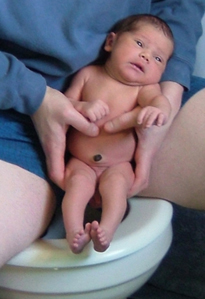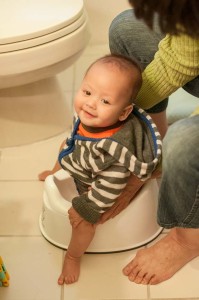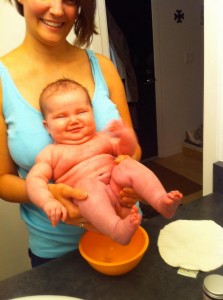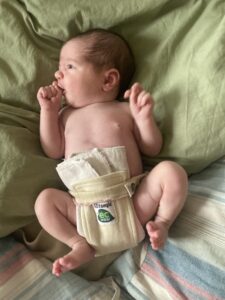
We are so glad you are interested in started Elimination Communication with your baby! Its a wonderful way to connect with your baby and do something great for the planet at the same time.
One way to start is to jump right in. Just take the diaper off and take your baby to a potty! You just might be surprised!
If you want to be more methodical, or if you are feeling unsure how to move forward after a first “lucky” catch, here are some of the steps that are generally recommended for a modern practice of Elimination Communication.
Observation and Cueing

What you will find very helpful at the beginning of your EC journey is to take some time to observe your baby’s patterns and body language, and for you to create a cue sound association. The next time you are hanging out with your baby, take her diaper off. If you are more comfortable, you can use a non-waterproof diaper without a cover, or a non-waterproof training pant, but not a disposable or waterproof diaper.
Don’t worry. This is temporary. You don’t need to leave your baby literally diaper-free (or naked) 24 hours a day to practice Elimination Communication. Its okay to use diapers while practicing EC, but you should start with at least a couple of diaper-free observation sessions so you can observe your baby’s body language or cues. If you can’t tell when she’s going, you won’t be able to communicate about it. When she pees or poops, you will explain it and make a cue sound.
The goal during this observation and cueing session is for your baby to form an association between pottying and your cue sound. Babies do understand! Just say something along the lines of “you are peeing. Pssss.” Don’t jump up and run your baby to a toilet. This could be startling or potentially frightening to your baby. Just be sure there is a cloth diaper, towel, or something else under your baby to catch the pee or poop.

During this phase, the priority is to start talking about pottying. You want to give your baby the understanding that everyone pees and poops. Its not a big deal. Its not dirty or disgusting– everyone just has to do it, many many times in our lives!
People often ask me why should they talk to their baby. There is a common misperception that babies cannot understand. But they do understand much more than we think they do! And the more you talk to your baby, you are greatly benefiting your baby’s brain development. The more you talk to your baby, the more you are building your child’s vocabulary, and while they are learning the meaning of all the words they hear, they will understand the intent from the context and tone.

Talking about what’s going on with pottying helps your baby understand her bodily functions, and it will also help with speech and brain development. Its also soothing and builds a trust relationship. If you haven’t done this before it may take some getting used to. Here is an example. “Oh, I just noticed your diaper is wet. You peed. Let’s get this wet diaper off. You’ll be much more comfortable in this clean and dry one. This diaper is blue. Blue is my favorite color….” etc. The language exposure helps your baby learn to talk and paves the way for future success in reading, too! While you are going through this initial observation phase, you may learn that your child gives you some indications when she is about to eliminate. Many people find the “poop face” pretty easy to identify. Your baby may get really quiet or look away from you before peeing.
If you cannot see any signals, don’t worry. Most of us have lived our entire lives without ever having seen anyone potty a baby, so don’t be hard on yourself. Just focus on the communication from your side, and continue to observe. Your child will eventually start to tell you in ways that are more obvious to you.
Potty time!
 After you’ve done a few sessions of observation and cuing, you can start taking your baby to the toilet or other appropriate place, and make your cue sound (e.g. “psss!”). You may be surprised how quickly your baby catches on, and responds to your cue by peeing! The best time to get a catch is when your baby is likely to need to pee, such as when they first wake from a nap, or when you are getting out of the car after a drive somewhere. If you don’t have any response with your first attempts, continue with the observation and cueing phase, and try again later.
After you’ve done a few sessions of observation and cuing, you can start taking your baby to the toilet or other appropriate place, and make your cue sound (e.g. “psss!”). You may be surprised how quickly your baby catches on, and responds to your cue by peeing! The best time to get a catch is when your baby is likely to need to pee, such as when they first wake from a nap, or when you are getting out of the car after a drive somewhere. If you don’t have any response with your first attempts, continue with the observation and cueing phase, and try again later.
Babies can also tell us if they don’t want to use the toilet, through vocal protesting, arching their back, or looking away. “Oh, I see you didn’t need to pee right now. I’m so glad you told me. Let’s go play with your rattle now!” Sometimes the “I don’t want to potty” signals are much more obvious than the “I want to potty” signals.
 When your baby does pee in the potty you’ll probably be excited! Now you can communicate that he peed in the potty. “You peed. Psss. How comfortable, nice and dry, with a quick pat to wipe and back to playing.”
When your baby does pee in the potty you’ll probably be excited! Now you can communicate that he peed in the potty. “You peed. Psss. How comfortable, nice and dry, with a quick pat to wipe and back to playing.”
Be mindful that praising can undermine efforts to normalize body functions and turn it into something your child should do to please you – rather than for herself. But of course you can show if you are happy, by smiling and acknowledging your feelings, especially the first time! “I’m so excited that we are trying elimination communication and you peed in the potty! I’m so happy I figured out when you needed to go!” A “woohoo!” is not going to hurt. The concern is about getting into the vacuous “Good job, Good peeing!” kind of praise which can make pottying into something your baby feels she needs to do to win your affection (or withhold when mad at you.)
The Focus of EC
Remember to start out with a focus on communication, responsiveness, and bonding. The goal is not to get it all “in a potty” but rather to help your child understand the process and gradually learn about where we are supposed to (in our culture) go, and eventually learn the skills to move ourself to the potty, get clothes out of the way, sit (or stand) in the right place, wipe up afterwards, and flush.
So don’t hesitate. Next time your baby wakes from a nap or finishes nursing, give it a try. Its fun!
Dressed for (EC) Success
Learn more about the most popular clothing used for easy Elimination Communication:
- Diaper Belts
- rECtangle™ diaper covers
- Split Pants: EC Wear Split Pants™, L’il Baby Chaps™ and Re-Ewes™ Wool Split Pants
- Additional clothing categories to consider are covered in our EC Clothing Guide
Feeling Frustrated?
If you feel frustrated, remember that in places where EC is the normal practice, parents receive support from their families and friends, all who have practiced EC. You can find the support you need by joining an EC Support Community. You can also read about other families’ adventures with Elimination Communication on a number of blogs.


You must be logged in to post a comment.